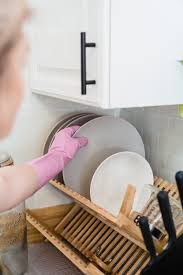Your Cart is Empty
FREE Worldwide Shipping! | +1 365 654 6605
FREE Worldwide Shipping! | +1 365 654 6605
December 30, 2023 4 min read

Shelving units are essential for storing and organizing various items in a kitchen. From pots and pans to pantry items and utensils, shelves offer a versatile storage solution. There are different types of shelving options to consider based on your kitchen's needs. A single shelf is a practical option for areas that can't accommodate a full shelving unit. It can be installed above the cooking area to hold commonly-used spices or keep frequently-used utensils within easy reach. Fixed shelves are a staple in modern, professional kitchens. They are commonly found in walk-in fridges or pantry areas to store vital food and ingredients. These shelves can be built-in or bolted down to maximize space and accommodate various items. Stand-alone shelving units are ideal for organizing specific areas in the kitchen that require additional storage. Whether it's pots and pans or utensils, these units can create extra space and improve organization. Racks are another valuable tool for efficient kitchen organization. They are particularly useful for smaller items and can be utilized in a variety of ways to maximize space. Vertical racks are a popular choice as they take up minimal space in the kitchen. They can be used to organize pans, pot lids, cutting boards, and other essentials. These racks can be mounted on walls or placed on countertops for easy access. Horizontal racks provide similar functionality to vertical racks but may require more space as the entire rack sits on the counter. They are suitable for storing and organizing various kitchen items, ensuring everything is within reach. In a busy professional kitchen, moveable racks can be a valuable addition. They can be used for letting bread rise, cooling baked goods, or holding pre-baked desserts. These racks offer flexibility and convenience, allowing easy access to items when needed. Countertops and prep tables can take up significant space in a commercial kitchen, but it's essential to utilize the area underneath for storage. Under-table storage options such as drawers or shelves can be added to hold utensils or other essential items, keeping them within easy reach. Specialty appliances that are not commonly found in every kitchen can pose a storage challenge. To keep everything organized, consider storing these appliances on shelving units when they are not in use. This ensures they are easily accessible without taking up valuable counter space. In addition to shelving and racks, there are various tools and accessories that can further enhance kitchen organization and functionality. Let's explore some of these options: Storage bins are essential for grouping similar items together, preventing them from rolling off shelves or becoming disorganized. Clear plastic bins are ideal for refrigerators or freezers, while black or gray bins can be used for pots, pans, or utensils. Maintaining proper food rotation is crucial in a professional kitchen. Can rollers allow you to easily follow the first-in, first-out rule by organizing canned goods. They ensure that the newest cans are placed at the back, while the older ones roll forward for easy access. Labels play a vital role in keeping a kitchen organized. Whether using a label maker or creating your own, labeling shelves, bins, and drawers ensures that everything has a designated place. This simplifies the process of finding and returning items, making the kitchen more efficient. To maximize storage space in a commercial kitchen, it's important to think creatively and utilize every available area. Here are some space-saving tips to consider: Empty overhead space is often wasted. Consider adding additional shelves or storage solutions above fridges or cabinets to make use of the vertical space. This allows for more efficient storage without sacrificing the ergonomic layout of the kitchen. In smaller kitchens, stationary storage units can hinder workflow. Opt for moveable storage solutions such as shelves or carts with wheels. These can be easily moved to where they are needed and then rolled back to create more space when not in use. Maintaining cleanliness and tidiness is crucial for an organized kitchen. Labels can help assign specific places for items, but regular cleaning and tidying ensure that everything remains in its designated spot. Establish a cleaning schedule and encourage mutual accountability among kitchen staff. Efficient organization is the key to a functional and productive kitchen. By utilizing appliance racks, shelving, and additional organization tools, you can optimize your kitchen space and create a well-organized working environment. Consider the unique needs of your kitchen and explore the various options available to enhance organization and maximize efficiency. With a well-organized kitchen, you can streamline your workflow, reduce clutter, and focus on creating culinary masterpieces.
In a modern, professional kitchen, organization is key to maintaining efficiency and maximizing productivity. With the right storage solutions, you can transform your kitchen into a well-organized space where every item has its place. One effective way to optimize kitchen space is by utilizing appliance racks. These racks not only provide storage for various kitchen appliances but also help declutter countertops and create a more streamlined working environment. In this article, we will explore different types of appliance racks and how they can be used to enhance kitchen organization.
1. Shelving: The Backbone of Kitchen Organization
1.1 Single Shelf
1.2 Fixed Shelves
1.3 Stand-Alone Units
2. Racks: Compact Storage Solutions
2.1 Vertical Racks
2.2 Horizontal Racks
2.3 Moveable Racks
3. Under-Table Storage: Making the Most of Countertop Space
4. Specialty Appliances: Where to Store Them?
5. Additional Organization Tools: Enhancing Efficiency
5.1 Storage Bins
5.2 Can Rollers
5.3 Labels
6. Space-Saving Tips: Thinking Outside the Box
6.1 Think Vertical
6.2 Think Mobile
6.3 Be Clean and Tidy
Conclusion
References
Be the first to know about upcoming sales and promos. Get a 10% discount coupon when you subscribe!